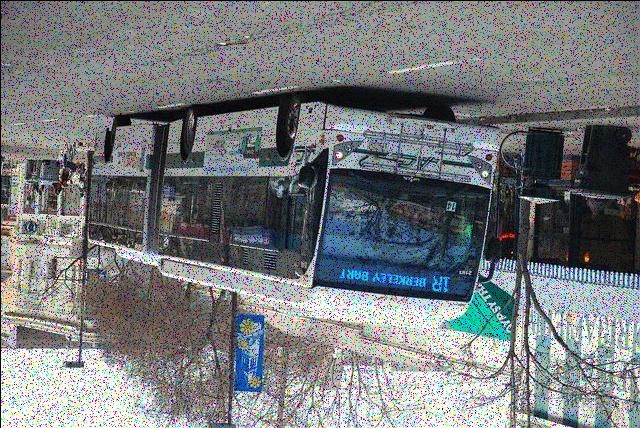对图片数据集进行数据增强操作
运行平台:pycharm
在对数据集进行训练的过程中,为了使网络模型具有更好的鲁棒性,通常我们需要对数据集进行数据增强处理,常见的处理方法有添加噪声、旋转、改变亮度等,如图1,2所示。
图1.原图(coco2017数据集)
图2.数据增强后效果(例)
数据增强代码:
import cv2
import numpy as np
import os.path
import copy
def SaltAndPepper(src,percetage):
SP_NoiseImg=src.copy()
SP_NoiseNum=int(percetage*src.shape[0]*src.shape[1])
for i in range(SP_NoiseNum):
randR=np.random.randint(0,src.shape[0]-1)
randG=np.random.randint(0,src.shape[1]-1)
randB=np.random.randint(0,3)
if np.random.randint(0,1)==0:
SP_NoiseImg[randR,randG,randB]=0
else:
SP_NoiseImg[randR,randG,randB]=255
return SP_NoiseImg
def addGaussianNoise(image,percetage):
G_Noiseimg = image.copy()
w = image.shape[1]
h = image.shape[0]
G_NoiseNum=int(percetage*image.shape[0]*image.shape[1])
for i in range(G_NoiseNum):
temp_x = np.random.randint(0,h)
temp_y = np.random.randint(0,w)
G_Noiseimg[temp_x][temp_y][np.random.randint(3)] = np.random.randn(1)[0]
return G_Noiseimg
def darker(image,percetage=0.9):
image_copy = image.copy()
w = image.shape[1]
h = image.shape[0]
#get darker
for xi in range(0,w):
for xj in range(0,h):
image_copy[xj,xi,0] = int(image[xj,xi,0]*percetage)
image_copy[xj,xi,1] = int(image[xj,xi,1]*percetage)
image_copy[xj,xi,2] = int(image[xj,xi,2]*percetage)
return image_copy
def brighter(image, percetage=1.5):
image_copy = image.copy()
w = image.shape[1]
h = image.shape[0]
#get brighter
for xi in range(0,w):
for xj in range(0,h):
image_copy[xj,xi,0] = np.clip(int(image[xj,xi,0]*percetage),a_max=255,a_min=0)
image_copy[xj,xi,1] = np.clip(int(image[xj,xi,1]*percetage),a_max=255,a_min=0)
image_copy[xj,xi,2] = np.clip(int(image[xj,xi,2]*percetage),a_max=255,a_min=0)
return image_copy
def rotate(image, angle, center=None, scale=1.0):
(h, w) = image.shape[:2]
# If no rotation center is specified, the center of the image is set as the rotation center
if center is None:
center = (w / 2, h / 2)
m = cv2.getRotationMatrix2D(center, angle, scale)
rotated = cv2.warpAffine(image, m, (w, h))
return rotated
def flip(image):
flipped_image = np.fliplr(image)
return flipped_image
file_dir = "img/"
for img_name in os.listdir(file_dir):
img_path = file_dir + img_name
img = cv2.imread(img_path)
rotated_90 = rotate(img, 90)
cv2.imwrite(file_dir + img_name[0:-4] + '_r90.jpg', rotated_90)
rotated_180 = rotate(img, 180)
cv2.imwrite(file_dir + img_name[0:-4] + '_r180.jpg', rotated_180)
for img_name in os.listdir(file_dir):
img_path = file_dir + img_name
img = cv2.imread(img_path)
flipped_img = flip(img)
cv2.imwrite(file_dir +img_name[0:-4] + '_fli.jpg', flipped_img)
img_salt = SaltAndPepper(img, 0.3)
cv2.imwrite(file_dir + img_name[0:7] + '_salt.jpg', img_salt)
img_gauss = addGaussianNoise(img, 0.3)
cv2.imwrite(file_dir + img_name[0:-4] + '_noise.jpg',img_gauss)
img_darker = darker(img)
cv2.imwrite(file_dir + img_name[0:-4] + '_darker.jpg', img_darker)
img_brighter = brighter(img)
cv2.imwrite(file_dir + img_name[0:-4] + '_brighter.jpg', img_brighter)
blur = cv2.GaussianBlur(img, (7, 7), 1.5)
cv2.imwrite(file_dir + img_name[0:-4] + '_blur.jpg',blur)



